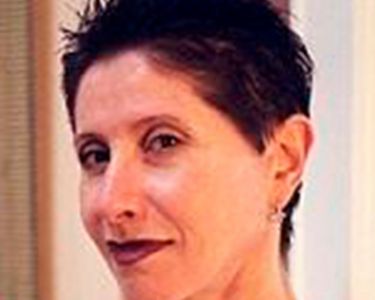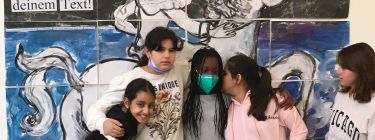
Curable Blindspot of Culture: How Participatory Arts Ignite Positive Change
Ira and Jewell Williams Professor of Romance Languages and Literatures and African & African American Studies at Harvard University and Director of Cultural Initiative at Harvard
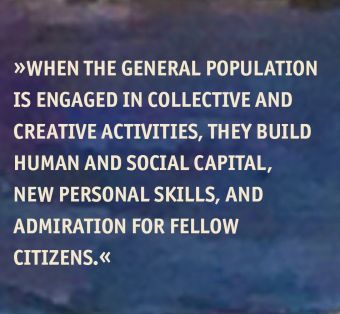
The Curable Blindspot of Culture: How Participatory Arts Ignite Positive Change
How Participatory Arts Ignite Positive Change
Culture is our necessary and renewable resource, the fourth pillar of sustainable development, though we often overlook it. The obstacle, in part, has been the word itself. Culture means two opposite things. One meaning is a heritage of shared beliefs, practices, and places, something to be protected rather than tampered with. This is the sense used by most decision-makers who are trained in the social sciences which privilege patterns over disruptions. The other sense is dynamic and familiar to artists and humanists who disrupt patterns and generate new relationships. One understanding is fixed, making culture either an obstacle to development or a fringe area for decoration and leisure, vulnerable to budget cuts. The other is edgy, experimental, and jealous of personal freedom. This difference in meaning causes a blind spot for both mayors and creatives who see past one another when collaborations are urgently needed to adjust outdated attitudes and behaviours that currently block development toward the SDGs.
Picture above: Copyright: Mannheim Public Library, Copyright Yilmaz Holtz Ersahin and Angelika Senft Rubarth
Today, in a post-pandemic world, we have an extraordinary opportunity to bring these visions together into bifocal projects. Shared beliefs and practices need to be refreshed and updated, as effective leaders know. The vast but under-acknowledged bank of evidence is witness to creativity’s power and potential. This includes a literature review by the WHO of 3,000 studies and an evidence base created by the EU and literally 100s of studies in specific cities. On the other hand, artistic interventions need to take stock of their practical effects, beyond personal satisfaction. Otherwise, we waste the creative resources that make us human. Collaborations will make us better citizens who can re-set our societies after the Covid 19 pandemic exposed habitual exclusions such as life and death inequities. Policies of inclusion in post-pandemic cities can count on participatory arts to foster collective belonging. Arts literacy projects will assimilate immigrants; and immigrant arts will enrich the local offer. (See www.pre-texts.org) The gains will be better security, physical and mental health, economic equity, and care in both senses of loving and taking responsibility for society. In sum, the power of arts as inclusion can energise cities across all dimensions.
The reason is clear. When the general population is engaged in collective and creative activities, they build human and social capital, new personal skills, and admiration for fellow citizens. Collaborations as well as supportive investments will harness the power of participatory arts, which is not the same as entertainment. Entertainment can be enjoyed passively, without engaging the energy of dynamic youth. Youth will build or ravage our cities; they actively participate in civic life or they reject it. And rejection can lead to violence, which simmers during lockdowns and has already exploded in many parts of the world. Our opportunity and obligation is to redirect youthful energy—we cannot extinguish it. Policing and punishment alone have not worked well, nor has single-minded investment in infrastructure. A few examples among many highlight the potential.
1. In 1995 newly elected Mayor Antanas Mockus of Bogota, Colombia faced a city mired in despair, violence and corruption. “Time to bring out the clowns,” counselled his Secretary of Culture. “Good idea,” responded the playful mayor. Twenty pantomime artists replaced twenty corrupt traffic police to shame irresponsible pedestrians and drivers. The shared laughter broke an apparently solid pattern of lawlessness. In the first year, there were 51% fewer traffic deaths. Many participatory arts initiatives followed, along with tax reform, transparency and infrastructural development. But art was the icebreaker. Within two administrations, homicides were reduced by almost 70%; tax revenues increased by 300%. This was “cultural acupuncture,” an approach developed from Jaime Lerner’s “urban acupuncture” for Curitiba, Brazil. Mockus added participatory art-making and accomplished astounding results.
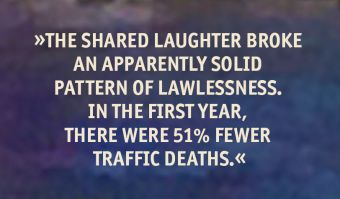
2. Edi Rama became World Mayor of the Year in 2004, mostly for painting the grey city of Tirana in bright colours. It did not solve all entrenched problems, but art did act as a catalyst to rediscover a pride of place and greater respect among citizens. An artist himself, Rama saw colour as more than decoration. It is a structural element to revive the civic spirit. “Beauty was acting like our guardsman… where municipal police, or the state itself, were missing.” This was his winning message in a campaign to become Prime Minister of Albania. Over the last few years, Tirana has made astonishing progress in its urban development, creating an urban forest belt of 2 million trees around the city core where children can plant a tree on their birthday. In 56 months, the city created 56 playgrounds in dilapidated parts of the city that act as gathering places and social connection points for all ages.
3. Broad-based music education has long proved to be a problem-solver, ever since El Sistema was established in Caracas over 50 years ago. By now, almost five million young people in Venezuela have benefitted from classical music training. It won’t make them all professional musicians, but it does teach discipline, focus,
collaboration, and dedication to beauty. Music-making, crucially, keeps vulnerable youth off dangerous streets. Many international projects have imitated this program with notable success.
4. This year Peter Kurz of Mannheim was awarded the World Mayor International Award. Much of his long-term work has involved using the arts to foster intercultural understanding and to regenerate troubled neighbourhoods such as Jungbusch. In Mannheim immigrants make up half of the population and former industries are giving way to new business models focused often on the creative economy. Sceptics about arts interventions sometimes object that they are not inspired, like Mockus, or trained as a painter, like Rama, or an engineer, like Lerner. Yet, Mayor Kurz is not himself an artist. Instead, his talent is to listen and to take small, cost-effective risks on art. One was his support for the School for Oriental Music, a unique initiative that a Turkish musician initiated to gather disaffected youth for rigorous time-consuming and community-building music lessons. This is one of many orchestrated ‘cultural acupuncture’ initiatives through which Mannheim addresses security and education by stimulating creative activities that foster diversity and belonging.
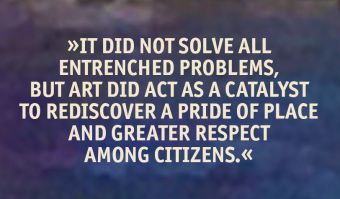
As part of a leader‘s toolbox, participatory arts can play a significant role in addressing the global challenges of SDGs. “Had I understood the power of arts to change behaviour and to drive prosperity, I would have made very different decisions as Minister of Development.” (José Molinas of Paraguay, formerly of The World Bank.) His change of perspective inspires a new “Certificate in Arts and Policy” for city governments in order to engage arts toward achieving a city’s goals, and to articulate particular goals with all the others. Each depends on the articulation: e.g. public health depends on education, transportation, violence prevention, etc. Education depends on public health, transportation, violence prevention, etc. The hybrid virtual and in-person sessions presents existing “Cases for Culture” and then customises co-constructions of new projects for the city’s challenges and resources. The Certificate complements the social science background of most leaders with humanistic thinking that recognises the arts as dynamic vehicles for developing human and social capital. (See https://renaissancenow-cai.org/wp/arts-and-policy/)
In a brief span of time, the Certificate in Arts and Policy consolidates deep European roots of democracy and development. Its people-centred approach can close the short circuit between high investments and low results, through cost-effective investments in art. Why does this work? A short answer is that the arts can include everyone. This means recognising art as the process of making, rather than products. Here participation and inclusion go together. This connection between participation and inclusion structures UNESCO’s broad-based program in arts education and entrepreneurship, “Towards 2030: Creativity Matters for Sustainable Development.”
Who is an artist and who an interpreter? Potentially all of us, to follow Friedrich Schiller who wrote Letters on the Aesthetic Education of Man in 1794. That was during the Terror of the French Revolution. Its shock value at the time was perhaps greater than our current pandemic and social upheavals. Slyly, he asks whether art may be an untimely topic for violent times. His affirmative answer is bold and compelling: Without art nothing changes. Humanity spirals into more violence, death, and despair.
Art is the name of development itself. It rejects inherited paradigms and it dares to experiment with new arrangements. If social science understands culture as a system of shared beliefs and practices, as Raymond Williams observed in Keywords, artists and humanists understand culture differently. It is confrontation with paradigms.
Schiller’s passionate call to action is to outsmart violence by breaking from habit and using frustration as a fuel to make something new, a surprise move, an unexpected creation that gives the maker a sense of autonomy and that stops the enemy in his tracks. This is trial and error—the way science works. And Schiller counts on our natural faculty to be creative. We have a drive to play, a Spieltrieb is his newly minted word. When we recognise the human condition as creative—which is evident precisely in under-resourced areas where people recycle and make-do—art is understood as a vital activity in which we all participate. Framing creativity as everyday resourcefulness to alter materials and relationships acknowledges the dignity of all people. Dignity follows from making because the artist is not a victim. Artists know that they have options and that they make decisions, even inside difficult constraints. This sense of autonomy and freedom within constraints is basic to citizenship. People feel proud of their creations and they respect beautiful things that others make. “Beauty was acting like a guardsman,” Mayor Edi Rama knew, “where municipal police, or the state itself, were missing.” He invited citizens to deliberate about colour and design to paint bright colours over old grey buildings. Even beautiful patrimonies of art, architecture, and monuments are there to be used. They offer historical continuity with precious urban spaces that link the past with the future. During the present COVID-19 restrictions on movement, digital programming has bought these sites of cultural heritage to an expanded virtual public.
Making autonomous choices through artistic practice channels the frustrations that many young people feel in our overcrowded and under-resourced neighbourhoods. Through art they can provoke and criticise in non-violent ways. “Symbolic violence” is another name for art and a pathway around the real thing.
Creativity is what distinguishes our species from other animals. Many are intelligent, but only human beings are imaginative beyond strategic thinking. Knowing this obliges us to create new things and new social arrangements. This is the theme that Josef Beuys made popular to repair the world after WWII when he established Documenta, the most important international art event, celebrated every five years in Kassel, Germany. As we speak, a stage of Documenta is being set for collaborations, because unlike previous editions, the 2022 event will promote community-oriented collectives. Artists have understood their urgent obligation to renovate creative practices and to adopt social and climate challenges. Today, artists, engineers, and educators offer initiatives to leaders who can recognise good bets and take necessary risks. This is the spirit of the early modern Renaissance. When the Medici bet on young Brunelleschi to build a monumental Cathedral dome, other investors scoffed at the folly. But the bet paid off, and the winners included the Medici, the artist and the entire city of Florence. In contemporary Italy, opera trucks are familiar interventions in immigrant neighbourhoods. Examples like these can help to ignite a new Renaissance Now with collaborations that take account of people’s creativity and that generate civic pleasure to keeps us engaged with each other as we face global challenges.
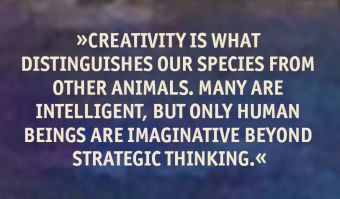
Doris Sommer
Doris Sommer is Ira and Jewell Williams Professor of Romance Languages and Literatures and of African and African American Studies at Harvard University. She directs the Cultural Agents Initiative at Harvard, and the Cultural Agents NGO dedicated to reviving the civic mission of the Humanities. Her projects include “Pre-Texts,” an arts-based training in literacy and citizenship, and Renaissance Now, a forum for rethinking culture in development. Her books include Foundational Fictions: The National Romances of Latin America (1991) about novels that helped to consolidate new republics; Proceed with Caution when Engaged by Minority Literature (1999) on a rhetoric of particularism; Bilingual Aesthetics: A New Sentimental Education (2004); and The Work of Art in the World: Civic Agency and Public Humanities (2014).Sommer’s work span’s Harvard’s Humanitarian & Cultural Initiative at the Mahindra Centre, the Executive Committee of the David Rockefeller Center for Latin American Studies, the American Studies Program, the Committee on Ethnicity, Migration, Rights (EMR); the Centre for Public Service and Engaged Scholarship & Global Health and Health Policy, South Asia Institute, and the Modern Language Association’s Working Group on K–16 Alliances. Recently, she prepared the Brief on Culture for the Summit of the Global Parliament of Mayors. Picture © Harvard Gazette
